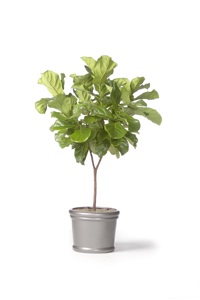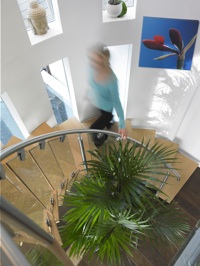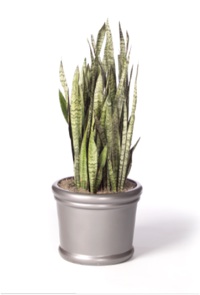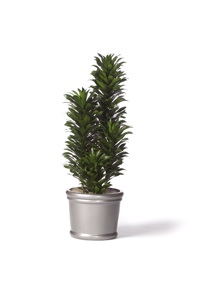
 March 25, 2009 – Our five senses are affected physiologically by everything in our path.
March 25, 2009 – Our five senses are affected physiologically by everything in our path.

|
|
| Plants provide a pleasant, tranquil environment in which to work or relax. |
|
 |
|
| Sansevieria Zeylanica | |
 |
|
| Ficus pandurata | |
 |
|
| Dracaena ‘Janet Craig’ |
Our five senses are affected physiologically by everything in our path. At Ambius, the world’s largest provider of interior landscapes for commercial environments, we enhance the quality of the work experience by engaging all five senses. Ambius has selected some of the plants which will heighten and satisfy our senses and help keep workplace environments happier and healthier.
Green plants provide many benefits, both physiological and psychological, to all our five senses. Plants are placed in buildings because they look attractive and help provide a pleasant, tranquil environment in which to work or relax. Research has shown that healthy, well-maintained plants can improve air quality, reduce background noise and affect peoples’ behaviour.
Plants reduce stress. Our heart rate, blood pressure and skin conductivity all benefit from the presence of plants. People in well-landscaped offices recover from stress more quickly than those in work environments without plants. If you work in an office building, it’s a good idea to keep a plant on your desk if possible, as well as other areas throughout the office. There are a number of easy-to-care-for indoor plants that provide sensory satisfaction.
VISUALLY PLEASING
Plants are not only visually stimulating and pleasing to the eye, they also serve as visual navigating cues. Well-designed plant displays can be very useful and inexpensive tools to help people find their way around a building.
Some visually arresting indoor plants that can provide navigational support include the Fiddle leaf fig, Ficus pandurata. Its bold leaves make a lasting impression that is not easily forgotten. The Variegated Bowstring, Sansevieria laurentii, is durable and strikingly vertical – ideal for restricted space. And the ever-popular Peace Lily, Spathiphyllum, one of the few indoor foliage plants that regularly flowers, is ideal for making a visual exclamation point.
SOUND MASTERS
Research carried out by Rentokil Initial, the parent company of Ambius, suggests that interior plants can absorb or reflect background noise in buildings, thereby making the environment more comfortable for the occupants.
Plants are generally more efficient in absorbing high sound frequencies than they are low frequencies. Recommended plants that keep office roars to a minimum include the Schefflera actinophylla (Umbrella Tree), multiple plantings of Dracaena massangeana (Corn Plant), and various species of Ficus (Weeping Fig). The greater the depth of the planting and the more diverse the mix, the better the results!
OFFICE PARTITIONING
Consider using screen plants instead of office partitions. Open-plan offices are often very noisy places. The hum of computers, the ringing of telephones and the buzz of conversation all make for a surprisingly noisy environment. Often these spaces are divided up with partitions or ranks of filing cabinets. Plant screens are an effective alternative.
Floor plants to use instead of partitions include the Chamaedorea erumpens (Bamboo Palm), Dracaena ‘Janet Craig’ (Janet Craig Dracaena), and Aralia elegantissima (False Aralia).
The tops of filing cabinets can also be used to place plants. Small bushy plants in narrow troughs take up little space, but can still be useful.
TACTILE CONNECTORS
For most office workers, we occasionally seek plants as tactile connectors simply because they feel pleasant to the touch. While many plants are a pleasure to touch, the following stand out as a distinct connection to nature.
- Calceolaria hybrida (the Pocketbook Flower) – this springtime beauty has velvet like blossoms.
- Almost all Bromeliads – architecturally radial foliage with strikingly brilliant flowers in a multitude of hues.
- <bu>Zamioculcas zamiifolia(ZZ Plant) – dark green foliage with a natural shine that beats almost all other indoor plants.
- Beaucarnea recurvata (Ponytail Palm) – curious, curling, papery foliage that rustles when touched.
PLEASINGLY FRAGRANT
Aroma Enhancers – Scientists recognize the power of the human sense of smell. Humans can identify hundreds of odours and many can trigger positive reactions and emotions. Using fragrant plants in our working landscape can enhance our mood.
White or pastel blossoms have stronger scents. This trait is probably to help them compete with their more brightly coloured cousins. Some recommended plants that are aroma enhancers include: gardenias, hyacinths, lilies, roses – all noted for their striking fragrance. Even blooming chrysanthemums possess a spicy aroma unique to their family alone. Occasionally available is the orchid Oncidium Sherry Baby, noted for its intense chocolate fragrance. Depending on the season and environment, foliage plants belonging to the genus Polyscias (often referred to as Arali) periodically emit a scent from their foliage reminiscent of freshly brewed coffee. This attribute should be enjoyed as a bonus if it happens, rather than an event to be depended on.
Plants are unique in how they showcase our innate sense of style and taste, but it is unwise to consume any ornamental plant produced for visual rather than edible purposes.
Businesses today place more emphasis on single, high quality plants in striking containers, to produce displays that have a “wow” factor. An ever-expanding range of plant varieties and container designs are available and a great deal of imagination is being applied to their use. As most of us get our daily greens from our salads, the following are some recommendations on plants that “strike a pose” with their elegance and style. The strong fragrance of blooming citrus trees is uniquely memorable. The satisfying scent of rosemary and eucalyptus, in addition to other herbs, that may be used as short-term accents; all evoke taste and aroma associations. Even Weber’s Blue Agave, Agave tequilana may bring to mind a refreshing, tasty libation. And of course, the exotic Vanilla fragrans is the basis for an extract whose flavour is beyond compare.
Plants truly engage all five senses in many powerful and subtle ways. Who can fail to be charmed by the graceful arch of palm leaves or the exotic beauty of orchids? Research continues to show that the value of plants goes far beyond the purely esthetic. Plants are actually good for the building and its occupants in a number of subtle ways and are an important element in providing a pleasant, tranquil environment where people can work or relax. Make your workplace greener, healthier and more beautiful by incorporating plants into your workplace.
Kenneth Brewer is the national technical and health and safety manager for Ambius, based in Buffalo Grove, Illinois.
ken.brewer@ambius.com
Print this page